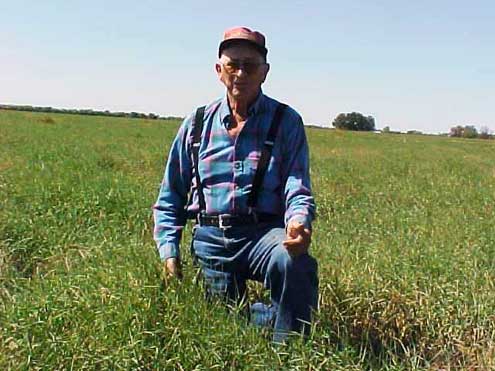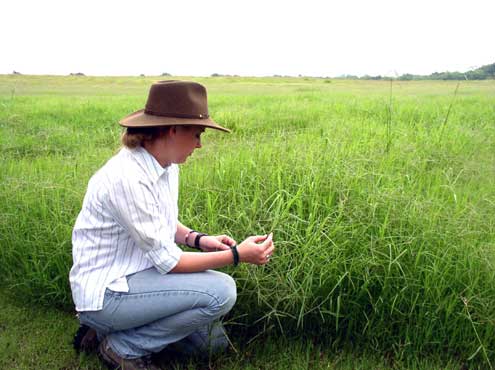Tifton 85, developed by Dr. Glen Burton, is a hybrid bermudagrass produced from the crossing of a South African grass and Tifton 68 which is highly digestible but susceptible to cold. Tifton 85 is distinguished from other bermudagrasses by its thicker stem and broader leaves; it is also sterile and does not produce any seed. It is taller than other bermudagrasses, with a darker green color and has very large, fast growing stolons.
Since being released in 1991, Tifton 85 has been the subject for research in productivity and economy as compared to Coastal bermudagrass, also developed by Dr. Burton.
Experimentation at the Coastal Plain Experiment Station in Tifton, Georgia where it was developed showed that Tifton 85 had productivity rates of 26% more forage that was 11% more digestible than Coastal bermudagrass. Furthermore, Tifton 85 has a higher nutritive content than the Coastal bermudagrass. Studies in at the Coastal Plain Experiment Station showed that Tifton 85 was more drought resistant than Coastal bermudagrass, but not any more cold resistant.

Leon Bowman, Windom, Texas, 2005 planting of Tifton 85.
Tifton 85 produces best in deep, droughty sands and although it can grow in clay and blacklands, blacklands are not optimum sites for bermudagrass. In 2000, Tifton 85 along with Coastal bermudagrass, seeded bermudagrasses and bahiagrass were subjects of study in Overton, TX. The study compared the productivity of these grasses by dry matter yield and in 2001 Tifton 85 was the highest yielding variety in the test.
This hybrid bermudagrass is a wonderful product for hay production and grazing. It has also become popular for stocker cattle. A study in Overton, TX in 2003 showed that stocker cattle had as much as 70% more daily weight gains on Tifton 85 than on the Coastal bermudagrass. Although the basic nutrient proportions of Tifton 85 are similar to Coastal bermudagrass, the increased digestibility rate allows ruminants to absorb more nutrients through their grazing.
To establish a successful stand of Tifton 85, preparations and planning must be made a year prior to planting. In the late summer of the year prior to planting, in order to reduce competition, destroy existing perennial vegetation. Obtain a soil sample and apply the recommended amounts of limestone during the land preparation. Two weeks after herbicide application, begin initial seedbed preparation and in order to reduce erosion and provide winter grazing for livestock, a small grain or ryegrass can be planted.
In March, disk the ryegrass or small grain under and apply any necessary phosphorous recommended by the soil sample results. Since Tifton 85 prefers warmer temperatures, the sprigs should not be dug and planted until the temperatures at night have reached the mid to upper 50’s.
When planting the Tifton 85, sprig into a (preferably) moist seedbed 2-2½ inches deep, but no deeper than 3 inches. Roll the seedbed. About two days after planting, treat the area with 1.5 to 3 pints/acre of Direx 4L or Diuron 4L pre-emergent herbicide. To maintain the health of the stand apply 40-60 lbs. of actual N/acre once the sprigs have begun to green up, along with any potassium recommended by the soil test. Finally, keep close control of broadleaf weed competition, applying appropriate herbicides when necessary.

C.J. Brinlee, NRS intern, inspects Tifton 85 grass stand on Jerry Chambers farm north of Ector, Texas.
For more information on bermudagrass planting and management, contact the USDA-NRCS office located at 200 E First Street, or call at 903-583-9531.